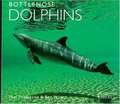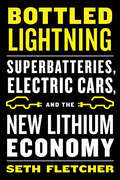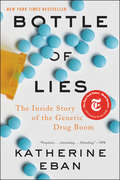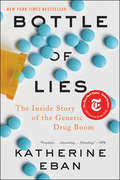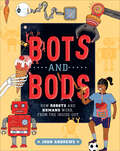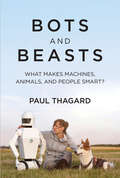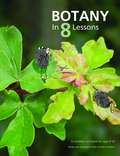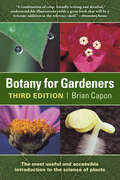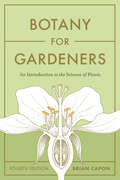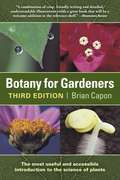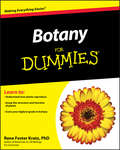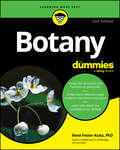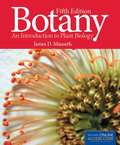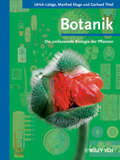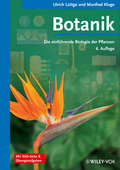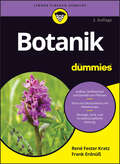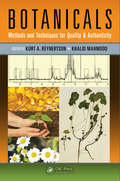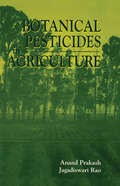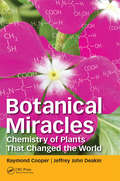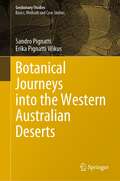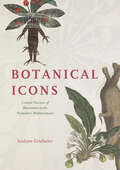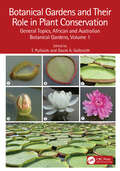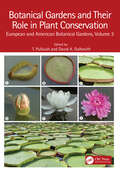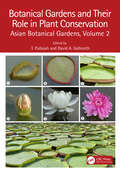- Table View
- List View
Bottlenose Dolphins (WorldLife Library)
by Paul Thompson Ben WilsonIntelligent, graceful and approachable, dolphins have long been among the worlds favorite sea creatures. Of all the dolphin species, the bottlenose is best known and loved. But bottlenose dolphins are more than television stars and aquarium performers. In Bottlenose Dolphins readers will voyage under the sea with researchers Paul Thompson and Ben Wilson, who are studying dolphins off the coast of Scotland. The authors explain the bottlenose dolphins oceanic habitat and range, and delve into their complex social relationships. They also share their concerns for the future of these beloved seafarers and suggest steps to protect them. Stunning color photographs accompany their insights.
Bottled Lightning: Superbatteries, Electric Cars, and the New Lithium Economy
by Seth FletcherLithium batteries may hold the key to an environmentally sustainable, oil-independent future. From electric cars to a "smart" power grid that can actually store electricity, letting us harness the powers of the sun and the wind and use them when we need them, lithium—a metal half as dense as water, found primarily in some of the most uninhabitable places on earth—has the potential to set us on a path toward a low-carbon energy economy. In Bottled Lightning, the science reporter Seth Fletcher takes us on a fascinating journey, from the salt flats of Bolivia to the labs of MIT and Stanford, from the turmoil at GM to cutting-edge lithium-ion battery start-ups, introducing us to the key players and ideas in an industry with the power to reshape the world. Lithium is the thread that ties together many key stories of our time: the environmental movement; the American auto industry, staking its revival on the electrification of cars and trucks; the struggle between first-world countries in need of natural resources and the impoverished countries where those resources are found; and the overwhelming popularity of the portable, Internet-connected gadgets that are changing the way we communicate. With nearly limitless possibilities, the promise of lithium offers new hope to a foundering American economy desperately searching for a green-tech boom to revive it.
Bottle of Lies: The Inside Story of the Generic Drug Boom
by Katherine EbanFrom an award-winning journalist, an explosive narrative investigation of the generic drug boom that reveals fraud and life-threatening dangers on a global scale—The Jungle for pharmaceuticalsMany have hailed the widespread use of generic drugs as one of the most important public-health developments of the twenty-first century. Today, almost 90 percent of our pharmaceutical market is comprised of generics, the majority of which are manufactured overseas. We have been reassured by our doctors, our pharmacists and our regulators that generic drugs are identical to their brand-name counterparts, just less expensive. But is this really true?Katherine Eban’s Bottle of Lies exposes the deceit behind generic-drug manufacturing—and the attendant risks for global health. Drawing on exclusive accounts from whistleblowers and regulators, as well as thousands of pages of confidential FDA documents, Eban reveals an industry where fraud is rampant, companies routinely falsify data, and executives circumvent almost every principle of safe manufacturing to minimize cost and maximize profit, confident in their ability to fool inspectors. Meanwhile, patients unwittingly consume medicine with unpredictable and dangerous effects.The story of generic drugs is truly global. It connects middle America to China, India, sub-Saharan Africa and Brazil, and represents the ultimate litmus test of globalization: what are the risks of moving drug manufacturing offshore, and are they worth the savings? A decade-long investigation with international sweep, high-stakes brinkmanship and big money at its core, Bottle of Lies reveals how the world’s greatest public-health innovation has become one of its most astonishing swindles.
Bottle of Lies: The Inside Story of the Generic Drug Boom
by Katherine EbanA NEW YORK TIMES BESTSELLER New York Times 100 Notable Books of 2019New York Public Library Best Books of 2019 Kirkus Reviews Best Health and Science Books of 2019Science Friday Best Books of 2019 New postscript by the authorFrom an award-winning journalist, an explosive narrative investigation of the generic drug boom that reveals fraud and life-threatening dangers on a global scale—The Jungle for pharmaceuticalsMany have hailed the widespread use of generic drugs as one of the most important public-health developments of the twenty-first century. Today, almost 90 percent of our pharmaceutical market is comprised of generics, the majority of which are manufactured overseas. We have been reassured by our doctors, our pharmacists and our regulators that generic drugs are identical to their brand-name counterparts, just less expensive. But is this really true?Katherine Eban’s Bottle of Lies exposes the deceit behind generic-drug manufacturing—and the attendant risks for global health. Drawing on exclusive accounts from whistleblowers and regulators, as well as thousands of pages of confidential FDA documents, Eban reveals an industry where fraud is rampant, companies routinely falsify data, and executives circumvent almost every principle of safe manufacturing to minimize cost and maximize profit, confident in their ability to fool inspectors. Meanwhile, patients unwittingly consume medicine with unpredictable and dangerous effects.The story of generic drugs is truly global. It connects middle America to China, India, sub-Saharan Africa and Brazil, and represents the ultimate litmus test of globalization: what are the risks of moving drug manufacturing offshore, and are they worth the savings? A decade-long investigation with international sweep, high-stakes brinkmanship and big money at its core, Bottle of Lies reveals how the world’s greatest public-health innovation has become one of its most astonishing swindles.
Bots and Bods: How Robots and Humans Work, from the Inside Out
by John AndrewsBots and Bods is an illustrated guide for kids looking to explore anatomy and technology and how they're related. How do we both move or sense the world? How does robot intelligence compare to our own? Middle-grade readers will find these answers and more among the four sections:Body structuresMuscle and movementSenses and sensorsThinking and feelingAn accessible guide with exciting illustrations, fun facts, and special feature spreads about robots in the real world explains why &“bots&” can sometimes do a better job than &“bods&” and vice versa.
Bots and Beasts: What Makes Machines, Animals, and People Smart?
by Paul ThagardAn expert on mind considers how animals and smart machines measure up to human intelligence.Octopuses can open jars to get food, and chimpanzees can plan for the future. An IBM computer named Watson won on Jeopardy! and Alexa knows our favorite songs. But do animals and smart machines really have intelligence comparable to that of humans? In Bots and Beasts, Paul Thagard looks at how computers ("bots") and animals measure up to the minds of people, offering the first systematic comparison of intelligence across machines, animals, and humans. Thagard explains that human intelligence is more than IQ and encompasses such features as problem solving, decision making, and creativity. He uses a checklist of twenty characteristics of human intelligence to evaluate the smartest machines--including Watson, AlphaZero, virtual assistants, and self-driving cars--and the most intelligent animals--including octopuses, dogs, dolphins, bees, and chimpanzees. Neither a romantic enthusiast for nonhuman intelligence nor a skeptical killjoy, Thagard offers a clear assessment. He discusses hotly debated issues about animal intelligence concerning bacterial consciousness, fish pain, and dog jealousy. He evaluates the plausibility of achieving human-level artificial intelligence and considers ethical and policy issues. A full appreciation of human minds reveals that current bots and beasts fall far short of human capabilities.
Botrytis - the Fungus, the Pathogen and its Management in Agricultural Systems
by Sabine Fillinger Yigal EladThe fungal genus Botrytis is the focus of intensive scientific research worldwide. The complex interactions between this pathogen and the plants it infects and the economic importance of the diseases caused by Botrytis (principally grey mould) on more than 1400 species of cultivated plants pre- and post-harvest, render this pathogen of particular interest to farmers, advisers, students and researchers in many fields worldwide. This 20-chapter book is a comprehensive treatise covering the rapidly developing science of Botrytis and reflecting the major developments in studies of this fungus. It will serve as a source of general information for specialists in agriculture and horticulture, and also for students and scientists interested in the biology of this fascinating, multifaceted phytopathogenic fungal species.
Botany in 8 Lessons: A Complete Curriculum for Ages 8-14
by Ellen MchenryA complete botany curriculum for ages 9-14 (grades 4-8 in the USA). Includes a 100-page student text plus a 150-page teacher's section. The student text is written in a lively, engaging style, often with a touch of whimsical humor, yet delves deeply into the science of how plants work. Each chapter ends with some follow-up activities such as word puzzles, quiz questions, and links to videos that illustration the concepts learned in the text. The teacher's section includes patterns and instructions for board games, group games, active games, art and craft activities, experiments, and even two songs. Ideal for homeschool or gifted education, but also a great resource for any classroom.
Botany for Gardeners: Third Edition (Science For Gardeners Ser.)
by Brian CaponA bestseller since its debut in 1990, this indispensable and handy reference has now been expanded and updated to include an appendix on plant taxonomy and a comprehensive index. Two dozen new photos and illustrations make this new edition even richer with information. Its convenient paperback format makes it easy to carry and access, whether you are in or out of the garden. An essential overview of the science behind plants for beginning and advanced gardeners alike.
Botany for Gardeners, Fourth Edition: An Introduction to the Science of Plants
by Brian Capon&“This should be the cornerstone of every gardener&’s library.&” —Jeff Gillman, Director of the UNC Charlotte Botanical Gardens What happens inside a seed after it is planted? How are plants structured? How do plants reproduce? The answers to these and other questions about complex plant processes can be found in the bestselling Botany for Gardeners. First published in 1990 with more than 260,000 copies sold, it has become the go-to introduction to botany for students and gardeners. Now in its fourth edition, Botany for Gardeners has been expanded and updated. It features a revised interior, with new photos and illustrations that clarify the concepts clearer than ever before. Additional updates address scientific advances, changes in nomenclature and taxonomy, and more. As before, Botany for Gardeners shares accessible information about how plants are organized, how they have adapted to nearly all environments on earth, their essential functions, and how they reproduce.
Botany for Gardeners (3rd edition)
by Brian CaponNew to the 3d edition of this well-illustrated text are four brief essays on human's relation to food, the possible impact of global warming on food supply, genetic modification of food, and the remarkable details to be seen with a scanning electron microscope. Other new additions are inset boxes expanding on the text with interesting facts and details, and additional photos. The volume, which is based on Capon's botany course for non-science majors (he is emeritus at California State U., Los Angeles) is an outstanding and enjoyable introduction to botany, whether the reader is a gardener, or just a garden visitor. Annotation ©2010 Book News, Inc., Portland, OR (booknews.com)
Botany For Dummies
by Rene Fester KratzThe easy way to score your highest in botanyEmployment of biological scientists is projected to grow 21% over the next decade, much faster than the average for all occupations, as biotechnological research and development continues to drive job growth.Botany For Dummies gives you a thorough, easy-to-follow overview of the fundamentals of botany, helping you to improve your grades, supplement your learning, or review before a test. Covers evolution by natural selectionOffers plain-English explanations of the structure and function of plantsIncludes plant identification and botanical phenomenonTracking a typical course in botany, this hands-on, friendly guide is your ticket to acing this required course for your major in biology, microbiology, zoology, or elementary education.
Botany For Dummies
by Rene Fester KratzHarvest basic botany knowledge from this abundant book Botany For Dummies gives you a thorough overview of the fundamentals of botany, but in simple terms that anyone can understand. Great for supplementing your botany coursework or brushing up before an exam, this book covers plant evolution, the structure and function of plant cells, and plant identification. Plus, you'll learn about how plants of different types are changing and adapting in response to changing climates. This new edition goes into more detail on fungi—not technically plants, but no one is holding that against them. Regardless of what brought you to the wonderful world of botany, this book will show you around. Get an easy-to-understand introduction to the key concepts in botany Read about recent discoveries and theories in the world of plant science Understand different families of plants and where they grow Improve your grade and pass your exam in your introductory botany course Get a copy of Botany For Dummies and watch your botany knowledge bloom.
Botany (5th Edition)
by James D. MausethAs new information is introduced and environmental changes occur, Plant Biology continues to develop and evolve as a science. Updated and revised to keep pace with these developments, the Fifth Edition of Botany: An Introduction to Plant Biology provides a modern and comprehensive overview of the fundamentals of botany while retaining the important focus of natural selection, analysis of botanical phenomena, and diversity. Students are first introduced to topics that should be most familiar (plant structure), proceed to those less familiar (plant physiology and development), and conclude with topics that are likely least familiar to the introductory student (genetics, evolution, and ecology). Mauseth is sure to provide the latest material on molecular biology and plant biotechnology in an effort to keep pace with these advancing areas of study. All sections are written to be self-contained allowing for a flexible presentation of course material. Key Features: - Includes new content on molecular biology, plant biotechnology, and the most recent coverage of taxonomy and phylogeny of plants. - Now available with a new electronic laboratory manual. - Plants Do Things Differently boxes help students understand and compare plant biology with human biology. - End-of-chapter study guide includes nearly 50 or more questions in each chapter, urging students to test themselves on the most important points in the chapter. - Alternatives boxes encourage students to think expansively about alternative aspects of plant biology that are more advantageous in certain conditions.
Botanik: Die umfassende Biologie der Pflanzen (Wiley-VCH-Lehrbuchkollektion 1)
by Ulrich Lüttge Manfred Kluge Gerhard ThielAs compact as possible and as comprehensive as necessary. The first edition of the "Lüttge/Kluge/Thiel" sets a new standard among German botany textbooks. It covers the entire field, from general and molecular basics right up to ecology and applications in biotechnology. The expert knowledge of the didactically experienced authors guides botany majors from the first semester of a bachelor degree right up to master's and beyond. Clear illustrations, chapter summaries, boxes on current research topics, glossaries and problems at the end of each chapter guarantee well-structured learning and perfect exam preparation - the best a textbook can offer. Website: WWW.WILEY-VCH.DE/HOME/BOTANIK
Botanik: Die einführende Biologie der Pflanzen
by Ulrich Lüttge Manfred KlugeSeit fast 25 Jahren eines der erfolgreichsten einführenden Botanik-Lehrbücher! Mit seiner durchdachten Themenauswahl und anschaulichen Darstellung ist es der ideale Einstieg für alle, die Botanik, auch als Nebenfach, erfolgreich studieren wollen. Das Konzept: - Umfasst als einziges Kurzlehrbuch die gesamten Pflanzenwissenschaften - Themenkästen mit kompaktem Wissen, Methoden und Begriffserklärungen - Zusammenfassungen nach jedem Kapitel für leichteres Lernen und Wiederholen - Das ideale Lehrbuch für Botanik-Einsteiger Neu in der 6. Auflage: - Aktualisiert insbesondere in den Bereichen Zellbiologie, Genetik und Umweltfaktoren - Jetzt mit Kapiteln zu Biotechnologie und Bionik - Erstmals mit Übungsaufgaben und Lösungshinweisen - Zahlreiche neue Abbildungen; alle Abbildungen elektronisch für Studenten und Dozenten kostenlos verfügbar unter: www.wiley-vch.de/home/botanik
Botanik für Dummies (Für Dummies)
by Frank Erdnüß Rene Fester KratzVon der Wurzel bis zum Blatt – alles, was die Botanik zu bieten hat Mit diesem Buch verschaffen Sie sich ganz einfach einen umfassenden Überblick über die Botanik. Von den zellbiologischen Grundlagen über die verschiedenen Pflanzengewebe und -strukturen bis hin zu Physiologie, Genetik, Systematik und Ökologie: Jederzeit leicht verständlich vermittelt es Ihnen das nötige Basiswissen, das Sie in Ausbildung, Studium oder als botanisch interessierte Person benötigen. Themen wie Biodiversität, Biotechnologie, Einfluss von Klima, Agrar- und Forstwirtschaft oder die Bedeutung von Pflanzen für den Menschen runden das Buch ab. Sie erfahren Was die grundlegenden Prinzipien pflanzlichen Lebens sind Wie Pflanzen auf Umweltbedingungen reagieren und sich vermehren Wie Pflanzen systematisch eingeteilt werden Welche Schlüsselrolle Pflanzen im Ökosystem zukommt
Botanicals: Methods and Techniques for Quality & Authenticity
by Ian MuehlenhausThe international trade in plants is growing steadily as the worldwide demand for natural and botanical raw materials increases. Customers value natural products and botanicals as "green" alternatives-safer ingredients for their families which also represent an environmentally and socially responsible choice for the planet. In order to build assura
Botanical Pesticides in Agriculture
by Anand Prakash Jagadiswari RaoDue to the prohibitive cost of synthetic pesticides and the problems of environmental pollution caused by continuous use of these chemicals, there is a renewed interest in the use of botanicals for crop protection. Agricultural entomologists, nematologists, and pathologists the world over are now actively engaged in research into the use of plants to fight agricultural pests and diseases, and to reduce the losses caused by them. Botanical Pesticides in Agriculture reviews the research on botanical pesticides used to combat losses due to pests of agricultural importance, with special attention focused on the use of higher plants. This book will serve as the baseline reference work for future research, and many of the botanicals discussed, such as neem, bael, begonia, pyrethrum, tobacco, karanj, and mahuwa, may become integral parts of pest control programs currently being developed. It is believed that botanical pesticides will minimize the undesirable side effects of synthetic pesticides and help preserve the environment for future generations.
Botanical Miracles: Chemistry of Plants That Changed the World
by Raymond CooperAs the shortcomings of purely synthetic approaches to biochemical discovery and development are becoming more apparent, a renaissance of interest in the chemistry of natural products as sources for new compounds is occurring. A unique approach to natural products chemistry, Botanical Miracles: Chemistry of Plants That Changed the World relates appl
Botanical Journeys into the Western Australian Deserts (Geobotany Studies)
by Sandro Pignatti Erika Pignatti WikusThe book contains detailed descriptions of the unique desert environment with particular emphasis on vegetation and survival strategies of plants. Nine expeditions through the Southwest of Western Australia over a period of 15 years triggered the interest of the authors to explore also some deserts in the region, which leads to three further excursions into the sandy dunes of the desert. Observations of plant life in the deserts focused not only on identifying plants, but also on gaining some understanding of the aboriginal desert people of centuries past, and their own survival strategies in such extreme conditions. Also part of the Canning Stock Route was followed and explored, but the most rewarding and interesting finds were done criss-crossing the desert away from highways, tracks, and paths. The most remote areas showed species richness and surviving strategies which by far exceeded expectations.
Botanical Icons: Critical Practices of Illustration in the Premodern Mediterranean
by Andrew GriebelerA richly illustrated account of how premodern botanical illustrations document evolving knowledge about plants and the ways they were studied in the past. This book traces the history of botanical illustration in the Mediterranean from antiquity to the early modern period. By examining Greek, Latin, and Arabic botanical inquiry in this early era, Andrew Griebeler shows how diverse and sophisticated modes of plant depiction emerged and ultimately gave rise to practices now recognized as central to modern botanical illustration. The author draws on centuries of remarkable and varied documentation from across Europe and the Mediterranean. Lavishly illustrated, Botanical Icons marshals ample evidence for a dynamic and critical tradition of botanical inquiry and nature observation in the late antique and medieval Mediterranean. The author reveals that many of the critical practices characteristic of modern botanical illustrations began in premodern manuscript culture. Consequently, he demonstrates that the distinctions between pre- and early modern botanical illustration center more on the advent of print, the expansion of collections and documentation, and the narrowing of the range of accepted forms of illustration than on the invention of critical and observational practices exclusive to modernity. Griebeler’s emphasis on continuity, intercultural collaboration, and the gradual transformation of Mediterranean traditions of critical botanical illustration persuasively counters previously prevalent narratives of rupture and Western European exceptionalism in the histories of art and science.
Botanical Gardens and Their Role in Plant Conservation: General Topics, African and Australian Botanical Gardens, Volume 1
by T. Pullaiah David A. GalbraithApproaching the contributions of a world-wide sector of scientific institutions to addressing the extinction crisis, Botanical Gardens and Their Role in Plant Conservation brings together a diversity of perspectives. There are more than 3,600 botanical gardens worldwide, where trees, shrubs, herbs, and other plants are studied and managed in collections. They are foremost among efforts to conserve the diversity of living plant species and ensure that crucial biodiversity is available for the future of humanity. This book is a showcase for plant conservation, restoration, biodiversity, and related scientific and educational work of botanical gardens around the world, featuring both thematic overview chapters and numerous case studies that illustrate the critical role these institutions play in fighting extinction and ensuring plant diversity is available for sustainable use. FEATURES A wide range of case studies derived from practical experience in a diversity of institutional, national, and biogeographical settings, Reviews of topics such as networking amongst institutions, the importance of global policy agreements such as the Convention on Biological Diversity and the Global Strategy for Plant Conservation, Profiles of botanical gardens contributions at the national level to conservation priorities, Real-world examples of programs in plant conservation for both critically endangered wild plant diversity and unique horticultural or cultural germplasm. Botanical Gardens and Their Role in Plant Conservation includes contributions from institutions from Africa, Asia, Australia, Europe, and the Americas, and institutions of all sizes and histories, from long-established national gardens to new gardens offering their perspectives on developing their roles in this vital undertaking.
Botanical Gardens and Their Role in Plant Conservation: European and American Botanical Gardens, Volume 3
by T. Pullaiah David A. GalbraithApproaching the contributions of a world-wide sector of scientific institutions to addressing the extinction crisis, Botanical Gardens and Their Role in Plant Conservation brings together a diversity of perspectives. There are more than 3,600 botanical gardens worldwide, where trees, shrubs, herbs, and other plants are studied and managed in collections. They are foremost among efforts to conserve the diversity of living plant species and ensure that crucial biodiversity is available for the future of humanity. This book is a showcase for plant conservation, restoration, biodiversity, and related scientific and educational work of botanical gardens around the world, featuring both thematic overview chapters and numerous case studies that illustrate the critical role these institutions play in fighting extinction and ensuring plant diversity is available for sustainable use. FEATURES A wide range of case studies derived from practical experience in a diversity of institutional, national, and biogeographical settings, Reviews of topics such as networking amongst institutions, the importance of global policy agreements such as the Convention on Biological Diversity and the Global Strategy for Plant Conservation, Profiles of botanical gardens contributions at the national level to conservation priorities, Real-world examples of programs in plant conservation for both critically endangered wild plant diversity and unique horticultural or cultural germplasm. Botanical Gardens and Their Role in Plant Conservation includes contributions from institutions from Africa, Asia, Australia, Europe, and the Americas, and institutions of all sizes and histories, from long-established national gardens to new gardens offering their perspectives on developing their roles in this vital undertaking.
Botanical Gardens and Their Role in Plant Conservation: Asian Botanical Gardens, Volume 2
by T. Pullaiah David A. GalbraithApproaching the contributions of a world-wide sector of scientific institutions to addressing the extinction crisis, Botanical Gardens and Their Role in Plant Conservation brings together a diversity of perspectives. There are more than 3,600 botanical gardens worldwide, where trees, shrubs, herbs, and other plants are studied and managed in collections. They are foremost among efforts to conserve the diversity of living plant species and ensure that crucial biodiversity is available for the future of humanity. This book is a showcase for plant conservation, restoration, biodiversity, and related scientific and educational work of botanical gardens around the world, featuring both thematic overview chapters and numerous case studies that illustrate the critical role these institutions play in fighting extinction and ensuring plant diversity is available for sustainable use. FEATURES A wide range of case studies derived from practical experience in a diversity of institutional, national, and biogeographical settings, Reviews of topics such as networking amongst institutions, the importance of global policy agreements such as the Convention on Biological Diversity and the Global Strategy for Plant Conservation, Profiles of botanical gardens contributions at the national level to conservation priorities, Real-world examples of programs in plant conservation for both critically endangered wild plant diversity and unique horticultural or cultural germplasm. Botanical Gardens and Their Role in Plant Conservation includes contributions from institutions from Africa, Asia, Australia, Europe, and the Americas, and institutions of all sizes and histories, from long-established national gardens to new gardens offering their perspectives on developing their roles in this vital undertaking.
